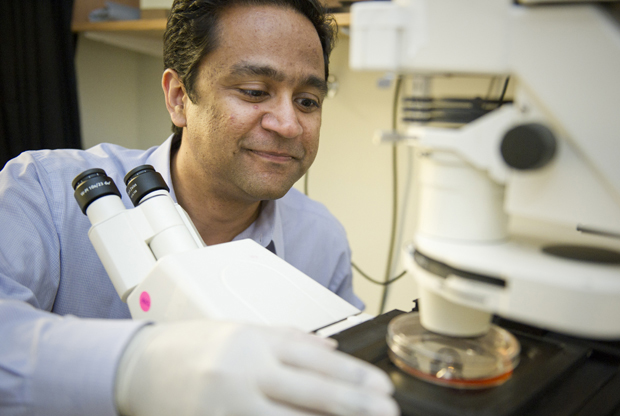Cells: The body’s ultimate sports car

Anand Asthagiri can think of several reasons why a scientist would want to get behind the wheel of a cell — which he calls the “ultimate driving machine.” Having the ability to move a cell from Point A to Point B, he said, could revolutionize tissue engineering and transform the understanding of various diseases, including cancer.
“It’s a complex problem, but I think we can make headway on it if we think about the cell as an engineerable entity,” said Asthagiri, an associate professor of chemical engineering in Northeastern University’s College of Engineering.
In a paper published in February in the journal Langmuir, Asthagiri and postdoctoral researcher Keiichiro Kushiro present a simple means of designing “traffic patterns” to guide cell movement.
Asthagiri said one way cells can be encouraged to move in a particular direction occurs naturally in our body — for instance, when our immune system responds to attacks. In a process called chemotaxis, cells move across a gradient of attractant molecules, from areas of lower to higher concentration.
Cells move by sticking and crawling on an adhesive surface using a variety of regulatory molecules, Asthagiri said. “If the surface is uniformly adhesive, then they’ll just move randomly,” he explained. “If you present them in a gradient of chemoattractant, they’ll move toward the chemoattractant but you won’t get the fine control of where they go.”
“Fine control” interested Asthagiri and Kushiro. In previous work, the researchers defined a set of micro-patterns that could constrain the movement of cells over an adhesive surface. A stripe of adhesive molecules, for example, keeps cells moving within that area. A teardrop shaped pattern — which looks like a migrating cell — gives them directionality, moving toward the broad end and away from the narrow end.
This time, the team explored a hybrid of the two micro-patterns, inserting a stripe into the teardrop to create a spear shape. They aligned these adhesive spears in a track-like square and then let the cells wander. While Asthagiri expected the cells to move around the track with directionality and increased speed, he did not expect enhanced directionality.
“You put this piece in the middle that has no ability to endow directional bias but yet it does, so there’s clearly more going on in this hybrid,” Asthagiri explained. When cells are exposed to the stripe longer, they are more likely to turn despite the fact that stripes do not inherently promote turning.
Asthagiri and Kushiro are currently investigating why the combination of the two shapes makes for a more controllable system. They are also setting up “traffic patterns” made up of stripes, teardrops and spears to explore ways in which the method can be tuned to cause more directed cell movements.
“We are excited by this because it opens two very interesting avenues of opportunity,” Asthagiri said. “One avenue is to learn more about the fundamentals of how cells move and exploit it. The other exciting possibility is on the application side. Could we use this to send some cells one way and other types of cells another?”
If the latter proves true, Asthagiri said, then cancer cells could separate themselves from noncancerous cells and newly differentiated stem cells could go exactly where they’re needed in a tissue graft.